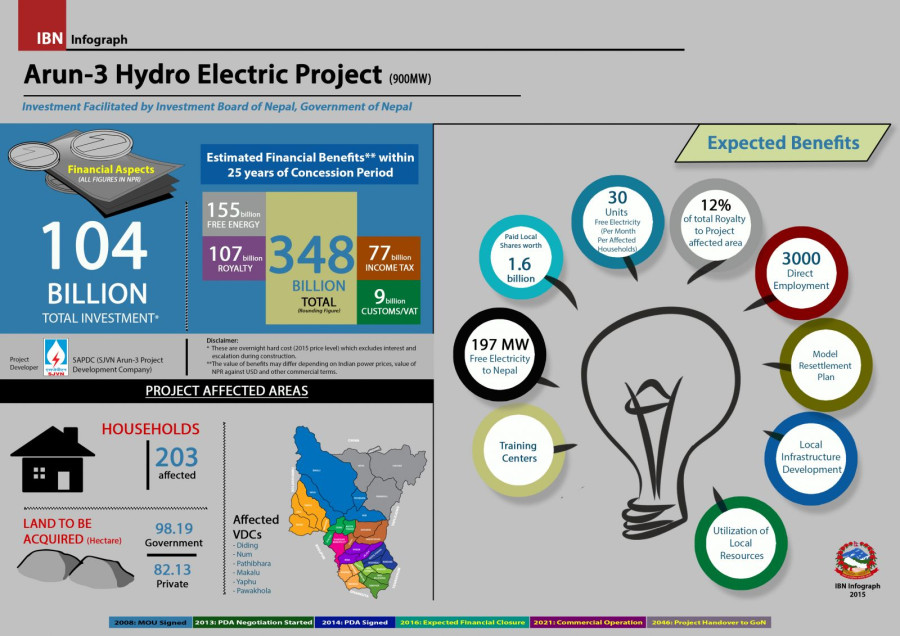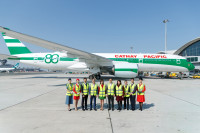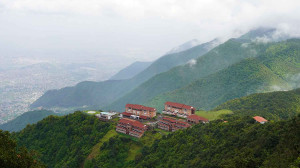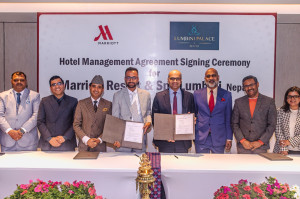Money
Locals obstruct work at Arun III over land compensation dispute
Residents blocked the access road complaining that they had not been paid compensation for a 24-km stretch.
Prahlad Rijal & Dipendra Shakya
Locals have prevented construction work from being done on the Arun III Hydro Electric Project over a land compensation dispute.
The 900-megawatt export-oriented plant is being developed on the Arun River in eastern Nepal by Indian state-owned Satlaj Jal Vidyut Nigam.
Residents blocked the access road to the tunnel site complaining that they had not been paid land compensation for a 24-km stretch from Chhyangkuti to the powerhouse in Diding.
The project has acquired 175 hectares of land, including 48.87 hectares of private land and 123 hectares of forest land for the construction of the scheme.
According to Harka Singh Rai, coordinator of the struggle committee, it is ironic that the project affected people have not received compensation even though 30 percent of the work has been completed.
“We have waited for three years, and we will not wait any longer, that is why we have started a protest,” said Rai.
The project has distributed Rs1.22 billion in compensation to the private landowners whose lands were taken over to build the plant.
Locals said the project paid them compensation to build a 15-metre wide road, but it acquired land for a 30-metre wide road at some places, and 200 affected households have not received the full compensation amount.
The then government acquired land on the Chhyangkuti-Pakhuwa road section in 1988-89.
“It is the government's responsibility to settle land compensation issues, not the project,” said Hare Ram Subedi, resident representative of Satlaj Jal Vidyut Nigam in Nepal. “The chief district office began talks with locals after they created an obstruction, and work is expected to resume after the local administration and project affected locals reach an agreement.”
According to Subedi, officials from Investment Board Nepal and the Survey Department are gathering information on private plots in a bid to resolve the dispute.
The Investment Board, the facilitating agency of the project, had formed a five-member task force in May to collect details of the land and the additional compensation that needed to be paid. The task force has sent its study report to the board, but the issue is yet to be resolved.
According to Maha Prasad Adhikari, the dispute over land compensation goes back to 1988, and locals have claimed that the project acquired extra land without paying adequate compensation.
“The task force has submitted its report, but the details of the land and the compensation amount are not complete,” said Adhikari. “We are carrying out an extensive survey; and without the proper details, we cannot ask the government to release payment. The people should not be impatient and create hurdles at such infrastructure projects.”
The project affected locals say they have been making the rounds of the Energy Ministry, Investment Board and other stakeholder agencies but getting nowhere.
“We even submitted a seven-point demand to the board, but nothing has been done to address our issues,” said Chetan Rai, deputy coordinator of the struggle committee which has obstructed construction crews from entering the project site.
According to Rai, the project disbursed land compensation in 2016 at the rate of Rs800,000 to Rs1.2 million per ropani, and in 2017 it slashed the compensation rate for certain sections to Rs500,000 per ropani. The locals want compensation to be paid at the previous rate.
Investment Board Nepal and Satlaj Jal Vidyut Nigam signed an agreement to develop the Arun III project under a build, operate and transfer model in November 2014. Satlaj Jal Vidyut Nigam has been carrying out construction work at the plant at a fast pace after Prime Minister KP Sharma Oli and Indian Prime Minister Narendra Modi jointly laid the foundation stone for the project remotely in May 2018 during Modi’s Nepal visit.
Nepal will receive Rs348 billion over 25 years from the project. The project developer will also provide 21.9 percent of the energy free of cost, which is worth Rs155 billion, plus another Rs107 billion in royalties.




 17.91°C Kathmandu
17.91°C Kathmandu
















